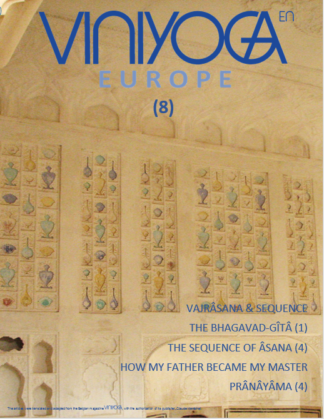Description
(32 pages)
VAJRÂSANA
For the first time we present a posture which is typically a seated one with the back straight.
Vajrâsana is an important position in yoga; it is the culmination of the practice of other postures. It allows us to practice prânâyâma and also offers us several possibilities of movement that have a positive influence on our cervical column. When combined specially with cakravâkâsana (which was studied in the last issue), it is often used as a counter posture or gentle preparation for other positions.
By Bernard Bouanchaud
SEQUENCE
This sequence associates vajrâsana to dvipâda pîtham and bhujangâsana. We prepare vajrâsana and then it is practiced in a static way; the other postures function either as preparation or bring a complementary action.
Other combinations are possible…
By Claude Maréchal
THE BHAGAVAD-GÎTÂ
In this article we focus on the first six chapters of the Bhagavad-Gîtâ; Richard Belfer introduces the character of Arjuna and explains the problems affecting him at the beginning of the famous text. It also shows the pedagogical strategy that Krishna uses with Arjuna, who is his student and friend. The master begins to explain the importance of the yoga of action and the meaning of responsibility to his disciple.
By Richard Belfer
THE SEQUENCE OF ÂSANA
A sequence of âsana can present particular characteristics because of the inclusion of a relevant number of postures of the same kind. Its function is related to the way it is built.
The first part of this article presents a “standing” sequence and a “lying” sequence.
By Claude Maréchal
HOW MY FATHER BECAME MY MASTER
Education by example: we transmit more what we are than what we know.
By T.K.V. Desikachar
PRÂNÂYÂMA
Aphorism II.49 of Yoga-Sûtra defines prânâyâma; in this article we are going to study aphorism II.50 which explains how to practice the breathing discipline.
By Claude Maréchal with the collaboration of Sylviane Gianina
YOGA-SÛTRA I.21 and 22
The effort, the seriousness and the intensity of the practice are notions constantly present in the work of Patanjali. They have been presented before.
Aphorisms I.21 & 22 give supplementary indications about the role and the effects of commitment.
Comments by Professor T. Krishnamacharya; presentation and explanations by T. K. V. Desikachar





